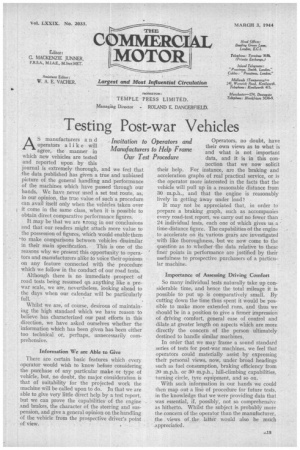Testing Post-war Vehicles
Page 15

If you've noticed an error in this article please click here to report it so we can fix it.
AS manufacturers a n d operators alike will agree, the manner in which new vehicles are tested and reported upon by this journal is extremely thorough, and we feel that the data published has given a true and unbiased Picture of the general handling and performance of the machines which have passed through our hands. We have never used a set test route, as, in our opinion, the true value of such a procedure can avail itself only when the vehicles taken over i it come in the same class, when it is possible to obtain direct comparative performance figures.
It may be that we are Prong in our conclusions and that our readers might attach more value to the possession of figures, which would enable them to make comparisons between vehicles dissimilar in their main specification. This is one of the reasons why we present this opportunity to operators and manufacturers alike to voice their opinions on any feature connected with the procedure which we follow in the conduct of our road tests.
• Although there is no immediate prospect of road tests being resumed on anything like a prewar scale, we are, nevertheless, looking ahead to the days when our calendar will be particularly full.
Whilst we are, of course, desirous of maintaining the high standard which we have reason to believe has characterized our past efforts in this direction, we have asked ourselves whether the information which has been given has been either too technical or, perhaps, unnecessarily comprehensive.
Information We are Able to Give • There are certain basic features which every operator would wish to know before considering the purchase of any particular make or type of vehicle, but, no doubt, the major consideration is that of suitability for the projected work the machine will be called upon to do. In that we are able to give very little direct help by a test report, but we can prove the capabilitiesof the engine and brakes, the character of the steering and suspension, and give a general opinion on the handling of the vehicle from the prospective driver's point ofview. Operators, no doubt, have their own views as to what is and what is not important data, and it is in this con nection that we now solicit their help. For, instance, are the braking and acceleration graphs of real practical service, or is the operator more interested in the facts that the vehicle will pull up in a reasonable distance from 30 m.p.h., and that the engine is reasonably lively in getting away under load? • It may not be appreciated that, in order to prepare a braking graph, such as accompanies every road-test report, we carry out no fewer than 24 individual tests, each one of which gives us a' time-distance figure. The capabilities of the engine to accelerate on its various geals are investigated with like thoroughness, but we now come to the question as to whether. the data relative to these ' finer points in performance are justified by their usefulness to prospective purchasers of a particular machine.
• Importance of Assessing Driving Comfort So many individual tests naturally take up considerable time, and hence the total mileage it is possible to put up is comparatively small. By cutting down the time thus spent it would be possible to make more extended runs, and thus we should be in a position to give a firmer impression of driving comfort, general ease of control and dilate at greater length on aspects which are more directly the concern of the person ultimately destined to handle similar machines.
In order that we may frame a sound standard series of tests for post-war machines, we feel that operators could materially assist by expressing their personal views, now, under broad headings such as fuel consumption, braking efficiency from 20 m.p.h. or 30 m.p.h., hill-climbing capabilities, turning circle, tyre equipment, and so on.
With such information in our hands we could then map out a line of procedure for future tests, in the knowledge that we were providing data that was essential, if, possibly, not so comprehensive as hitherto. Whilst the subject is probably more the concern of the operator than the manufacturer, the views of the latter would also be much appreciated.




















































